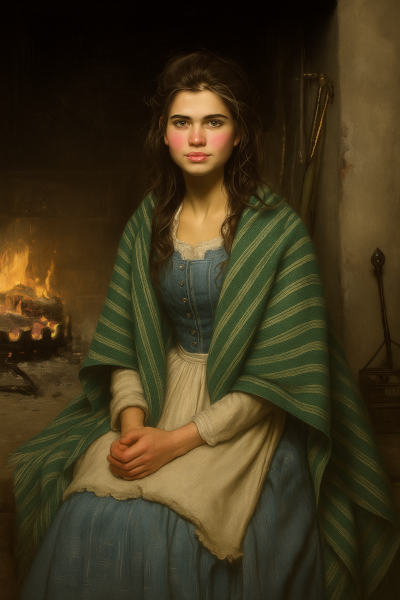Pelanne ((peh-LANN))
“A Pelanne fits all shoulders.”Traditional shawl or fieldwrap of the Bassier River Valley folk, the pelanne combines endurance and protection with subtle artistry. It is a highly versatile garment meant to be wrapped or draped across the shoulder and torso. The pelanne is used by all genders of folk, for everyday work or festivals, and is designed to be reversible, with a brushed fabric on one side, and a smooth one on the other. Some pelannes also include small hidden pockets within the seams, for coins or keepsakes.
A Wrap For the Fields
The Pelanne consists of a large rectangle of cloth approximately two feet wide and a full ell long. Traditionally made of wool, or a wool-blend, there are also lighter variations in linen, and sometimes even linen-cotton blends. Generally, the pelanne is dyed in muted colors and earthen-tones, often two shades of a similar color. The brushed fabric side is meant to be worn on the inside during colder weather, as it holds the warmth, while it is traditional to wear the smooth fabric side turned in during warm days, or rainy ones. Generally, it is worn over the shoulder, and wrapped around to where it is pinned near the armpit or belted at the waist. There are many quaint traditions relating to pelannes in the Bassier Valley. Traditionally, the wrap is only worn over the left shoulder for ordinary work days. This leaves the working hand free for daily tasks. Wearing it over the right shoulder is reserved for funerals and other formal occasions. When traveling, however, wearing the pelanne over both shoulders and pinning it in front is seen as perfectly acceptable. The versatile drape can be used as a head covering, blanket, or even an emergency sling or satchel, when need arises. For festival days, the lighter, brighter pelannes make an appearance. Gone are muted colors and subtle patterns, as the locals embrace bolder dyes, strong color contrasts and colorful embroidery. The festival version is more likely to be made of linen, or other bast-fibers. Only used on special occasions, a good festival pelanne is often handed down through a family for generations. It is no wonder that it often said that you should never buy your first pelanne, that it should be handmade, bartered for or a gift. The pelanne is also a cultural staple for weddings, as well. It is customary for the bride to make her own wedding day pelanne, and some of them take months, or even years working on the perfect pelanne to wear for her special ceremony. Patterns for these pelannes are expected to contain narrower stripes, chevrons, or other very fine patterns. Vinework is a popular motif, as of late. As it is supposed to showcase the bride's weaving skills, it does take time to make. The young woman will often use a special "side" loom set up in the loft of the house, or otherwise out of the way of regular weaving work. Some have theirs finished well in advance, and keep it carefully among cedar shavings.Weaving Patterns
Pelannes are woven locally in the valley. Generally, wool from local sheep, hand dyed, is used.There are a variety of local weaving patterns that are traditionally incorporated into the fabric, some so distinctive that versions of the garments have found favor all the way to Auberris and the courts of the King.- Thornhollow Weft - Hailing from the small village of Thornhollow, this dense, textured weave with narrow vertical striping, caused by clever manipulation of the weft. This weave is both warm and weighty, and even wind-resistant, popular among ferry drivers and during the colder parts of fall.
- Bendtwist - From the town of Coulson's Bend, this popular weave features subtle diagonal ribbing that shifts its direction halfway through, giving the appearance of a river bend. The tight weave makes it water-resistant, and durable. Most laborer's pelannes are of this weave.
- Mirelleth Drape - For warmer weather, the town of Mirelleth's traditional pattern is best. It features light chevron patterns along the pelanne, often done in soft colors like green and gold. This creates a fabric that is breathable and gentle.
- Delmarie Spiral - The intricate spiral pattern has taken much of Polira by storm. Not stitched or dyed in, the slightly raised spirals that dances across the pellannes of Delmarie are woven into the very fabric. The look is soft and elegant - and expensive, for a weave that complex is labor intensive. In the Bassier region, something like this is used at festivals or weddings only.
“If the wind gets through it, it’s not a Pelanne—it’s a napkin.”
Item type
Clothing / Accessory
Weight
1.75 to 2.5 lbs
Dimensions
2 feet x 1 ell
Base Price
10 silver
Raw materials & Components
Wool
Wool-blends
Linen
Linen-Cotton blends
Wool-blends
Linen
Linen-Cotton blends



Comments